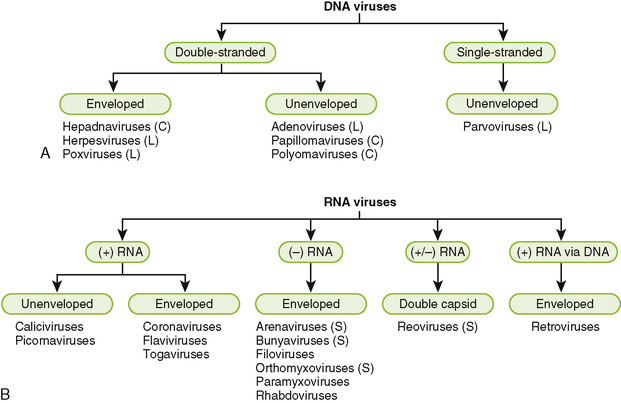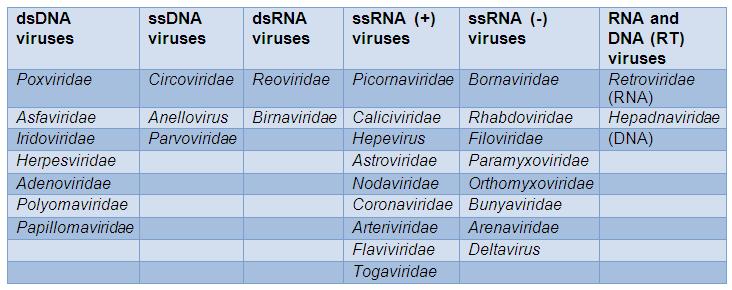
Classification of virus
A] Classification on the basis of nucleic acid
B] Classification on the basis of structure or symmetry
C] Classification on the basis of replication properties and site of replication
D] Classification on the basis of host range
E] Classification on the basis of mode of transmission
Classification of virus on the basis of nucleic acid

1. DNA virus:
- viral genome is DNA
i) Double stranded DNA virus: eg. Adenovirus, Herpesvirus
ii) Single stranded DNA virus: eg. Parvovirus, φ174 virus
2. RNA virus:
- genome is RNA
i) Double stranded RNA virus: eg. Reo virus
ii) Single stranded RNA virus: these are further classified into two groups
- Positive sense RNA (+RNA): Polio virus, Hepatitis A
- Negative sense RNA (-RNA): Rabies virus, Influenza virus
Some examples of DNA and RNA viruses:

Classification of virus on the basis of structure
1. Cubical virus:
- they are also known as icosahedral symmetry virus
- Eg. Reo virus, Picorna virus
2. Spiral virus:
- they are also known as helical symmetry virus
- Eg. Paramyxovirus, orthomyxovirus
3. Radial symmetry virus:
- eg.Bacteriophage
4. Complex virus:
- eg. Pox virus
Classification of virus on the basis of replication properties and site of replication
1. Replication and assembly in cytoplasm of host:
- Eg. All RNA virus replicate and assemble in cytoplasm of host cell except Influenza virus
2. Replication in nucleus and assembly in cytoplasm of host:
- Eg. Influenza virus, Pox virus
3. Replication and assembly in nucleus of host:
- All DNA viruses replicate and assemble in nucleus of host cell except Pox virus.
4. Virus replication through ds DNA intermediate:
- Eg. All DNA virus, Retro virus and some tumor causing RNA virus replicates through ds DNA as intermediates.
5. Virus replication through ss RNA intermediate:
- Eg. All RNA virus except Reo virus and tumor causing RNA viruses.
Classification of virus on the basis of host range:
1. Bacteriophage:
- Phage are virus infecting bacteria. Eg, λ phage, T2, T4, φ174, MV-11
2. Plant virus:
- Those virus that infects plants. Eg. TMV, cauliflower mosaic virus
3. Animal virus:
- Those virus that infects animals. Eg. Polio virus, Retro virus, Herpes virus, Adeno virus
4. Insect virus:
- Virus that infects insects. Eg. Baculovirus, Sacbrood virus, Entomopox virus, Granulosis virus
Classification of virus on the basis of mode of transmission:
1. Virus transmitted through respiratory route:
- Eg, Swine flu, Rhino virus
2. Virus transmitted through faeco-oral route:
- Eg. Hepatitis A virus, Polio virus, Rota virus
3. Virus transmitted through sexual contacts:
- Eg. Retro virus
4. Virus transmitted through blood transfusion:
- Eg. Hepatitis B virus, HIV
5. Zoonotic virus:
- virus transmitted through biting of infected animals;
- Eg. Rabies virus, Alpha virus, Flavi virus
